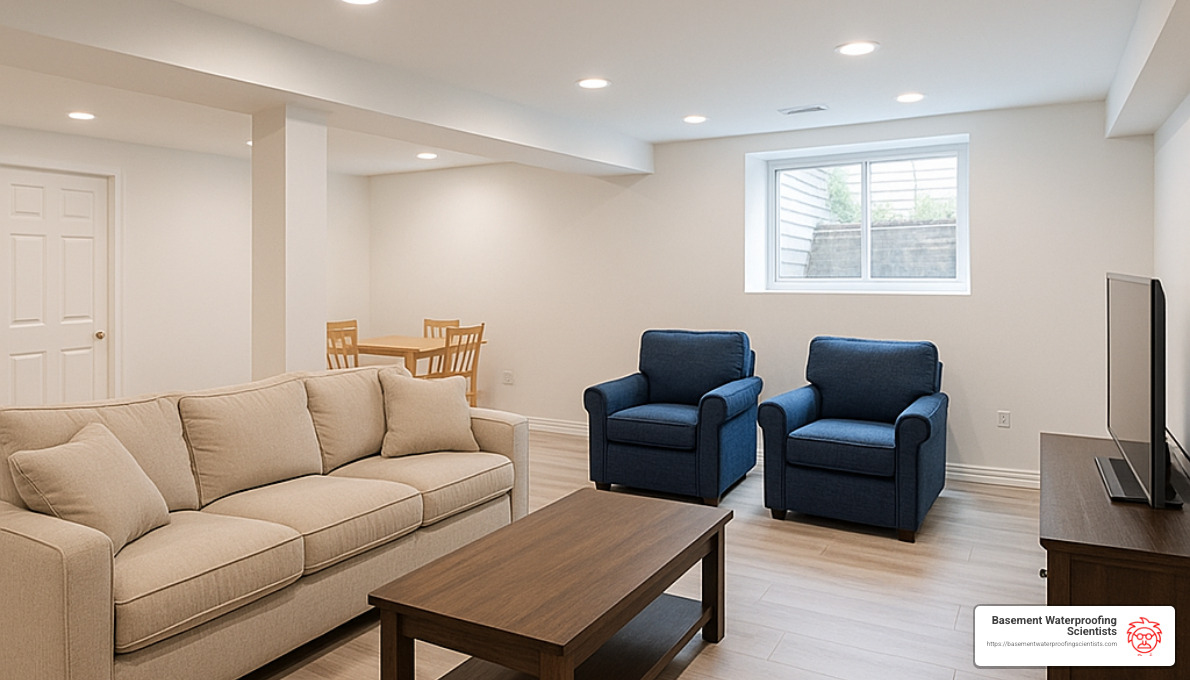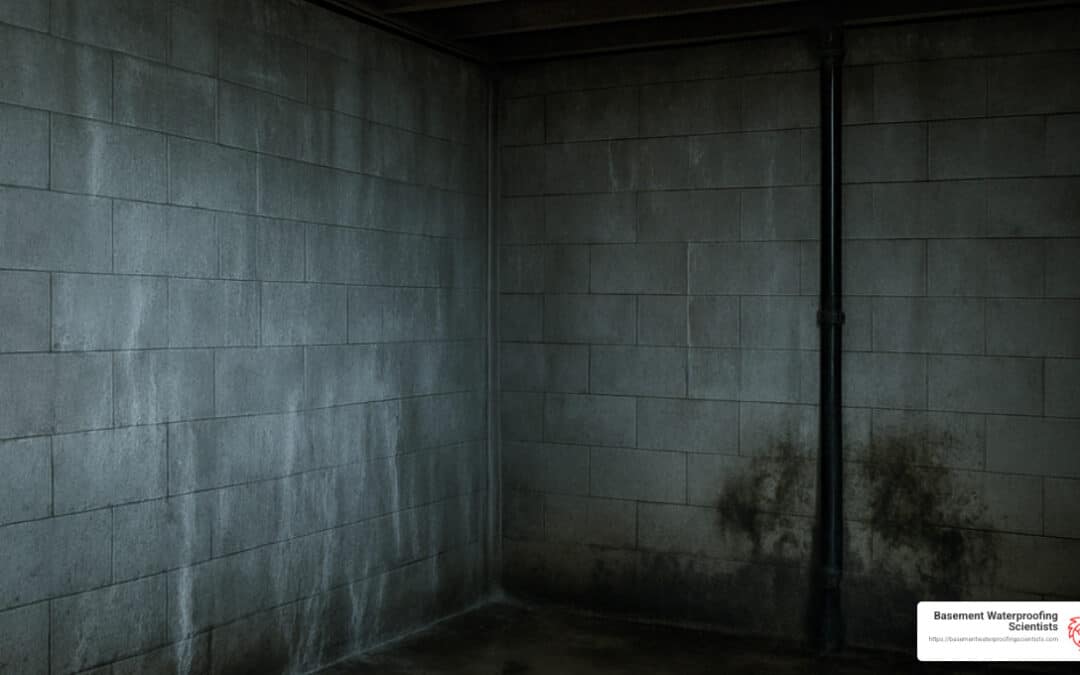Why Basement Air Quality Matters to Your Whole Home
That musty smell wafting up from your basement isn’t just an unpleasant odor—it’s your home trying to tell you something important. As someone who’s spent over three decades helping homeowners solve basement problems, I’ve seen how what happens below affects everything above. An important part of maintaining a healthy home is ensuring good air quality in the basement.
I’m Darin Garvey, and through my 30 years in basement waterproofing and basement air quality improvement, I’ve finded that many homeowners don’t realize they’re breathing basement air throughout their entire house. It’s true—up to 50% of the air circulating in your upstairs living spaces actually originates from your basement through what we call the “stack effect.” Just like a chimney pulls air upward, your home naturally draws air from the lowest levels up through the living areas and out through the roof.
Basement air quality improvement is achievable through five essential approaches:
- Control moisture with dehumidifiers (maintaining that sweet spot of 30-50% humidity)
- Improve ventilation using mechanical systems or air exchangers
- Use air purifiers equipped with HEPA and carbon filters
- Seal cracks and gaps in your foundation and walls
- Test for and mitigate radon if levels exceed the safety threshold of 4 pCi/L
To improve basement air quality, it is crucial to implement these methods, as they contribute to a healthier living environment throughout your home.
Why does this matter so much? Because excess moisture in your basement creates the perfect breeding ground for mold and mildew. These unwelcome guests don’t just stay put—their spores travel upward through your home, potentially triggering allergies, asthma attacks, and other respiratory issues for your family. Beyond health concerns, that damp air can silently damage your home’s structure through wood rot and even attract pests looking for a moist environment.
Addressing your basement’s air quality isn’t just about eliminating that telltale musty smell—it’s about creating a healthier living environment throughout your entire home while protecting what is likely your biggest investment. Think of it as preventative healthcare for both your family and your house.
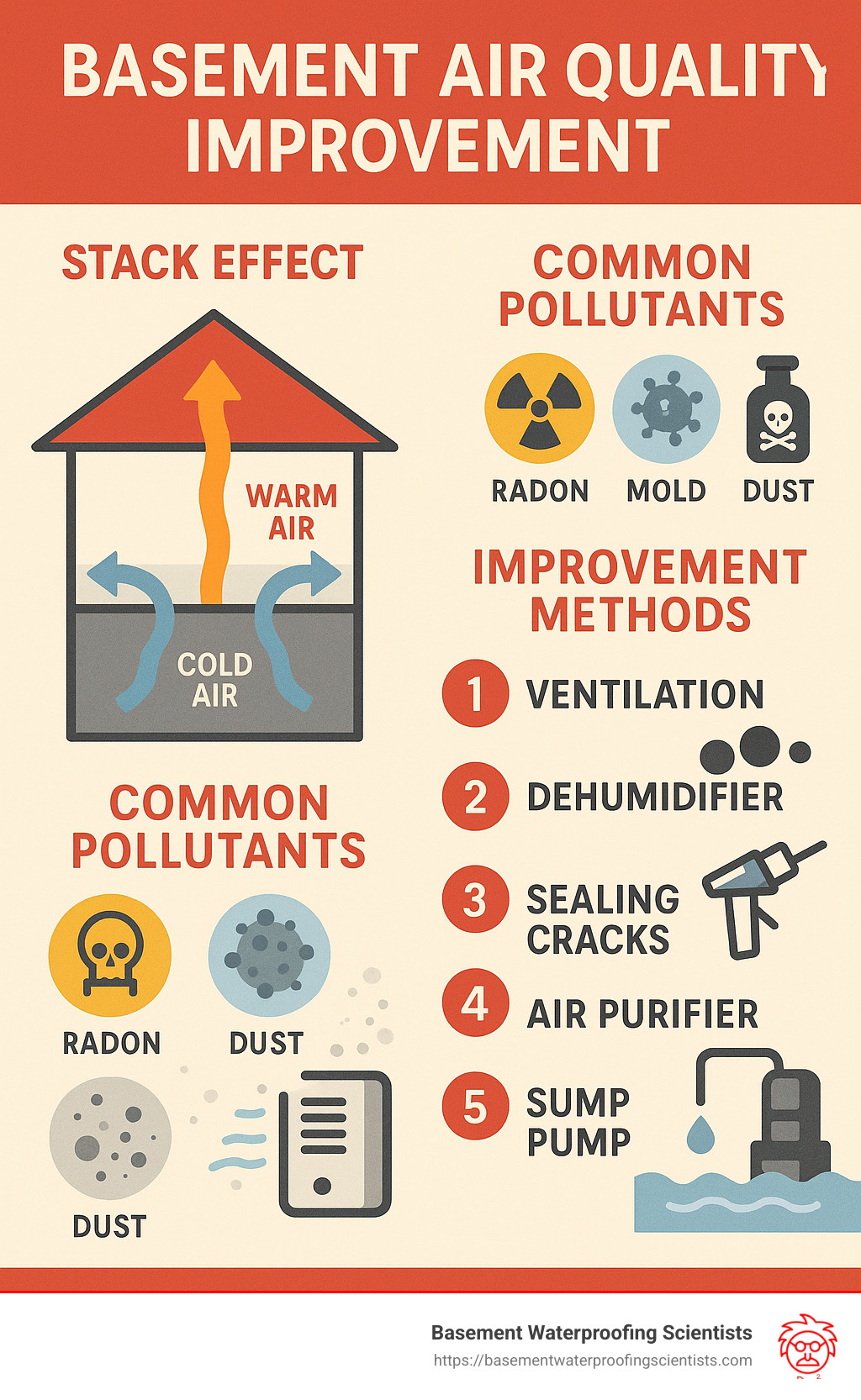
At Basement Waterproofing Scientists, we’ve transformed thousands of damp, problematic basements into clean, healthy spaces families can actually enjoy. If you’re concerned about your basement’s impact on your home’s air quality, you might want to explore these resources:
Basement air quality improvement basics:
What happens in your basement doesn’t stay in your basement—it rises up to affect your entire home. Taking steps to improve your basement’s air quality is one of the smartest investments you can make for both your property and your family’s wellbeing.
Basement Air Quality Improvement: Why It’s Critical
That space beneath your feet matters more than you might think. Your basement isn’t just a foundation—it’s the starting point for the air that circulates throughout your entire home. Understanding this connection is the first step toward creating a healthier living environment for your family.
Basement air quality improvement begins with identifying what’s actually polluting your air:
Moisture is usually the primary culprit. When water seeps through foundation walls or floors, it creates the perfect breeding ground for mold and mildew, especially when relative humidity climbs above 60%. According to EPA research on indoor humidity and mold, maintaining indoor humidity between 30-50% is crucial for preventing mold growth.
“When excess moisture is present in buildings, mold growth will often occur, particularly if the moisture problem remains unfinded or unaddressed,” the EPA warns in their guidance on indoor air quality.
But moisture isn’t the only concern. Radon—an invisible, odorless radioactive gas—can enter through foundation cracks and become trapped in your home. Meanwhile, those paint cans, cleaning supplies, and other chemicals stored in your basement release Volatile Organic Compounds (VOCs) that silently contaminate your air.
With limited natural ventilation, these pollutants have nowhere to go but up—right into your living spaces. Over time, these issues can deteriorate your home’s structure as water breaks down concrete, corrodes metal supports, and rots wooden beams. What starts as an air quality problem can quickly become a costly structural headache.
Key Health Risks & Hidden Costs of Ignoring Basement Air Quality
I’ve seen how poor basement air quality affects families throughout Pennsylvania. The health impacts can be both immediate and long-term:
Breathing becomes difficult when mold spores trigger coughing, wheezing, and throat irritation. For allergy sufferers, symptoms like red eyes, skin rashes, and nasal congestion can become a daily struggle. Those with asthma face even greater risks, as damp environments are known to trigger attacks. Additionally, harmful toxins such as mold and VOCs can exacerbate these health issues, making it crucial to assess and improve indoor air quality.
Perhaps most concerning is radon exposure. This silent threat causes over 2,000 lung cancer deaths annually—making it the second leading cause of lung cancer in America.
I remember working with a family in Norristown whose three children suffered from persistent coughing and allergies for months. After we implemented comprehensive basement air quality improvement measures, their symptoms disappeared within weeks. Their story isn’t unique—we see similar changes regularly.
Beyond health concerns, the financial impact can be substantial. Wood rot from ongoing moisture problems can lead to structural repairs costing thousands. Your energy bills climb as your HVAC system works overtime to condition damp air. When it comes time to sell, moisture problems can slash your property value by 10-25%. And let’s not forget the medical expenses that pile up when treating chronic respiratory conditions.
One homeowner in Lansdale finded their high winter heating bills were directly connected to basement humidity. After we installed proper waterproofing and dehumidification, their energy costs dropped by nearly 20%—a saving that continues year after year.
How Poor Air in the Basement Influences Your Entire House
Many people believe that closing the basement door keeps basement problems contained. Unfortunately, your home doesn’t work that way.
The “stack effect” is the physical principle that explains how air moves through your home. As warm air rises and escapes through your upper floors, it creates negative pressure below. This vacuum pulls air up from your basement, bringing along whatever contaminants exist there.

Research shows that up to 50% of the air on your first floor originates from below-grade spaces. This means mold spores, radon gas, and other pollutants from your basement are constantly circulating throughout your main living area and other living spaces.
I’ll never forget the shocked expression of a King of Prussia homeowner when our testing revealed basement contaminants present in their second-floor bedrooms. This findy transformed their understanding of home air quality—showing why basement air quality improvement must be viewed as a whole-house strategy, not just a basement fix.
When you improve your basement’s air quality, you’re actually improving the air throughout your entire home. It’s an investment that pays health dividends for every family member, in every room of your house.
Diagnose the Problem: Testing & Monitoring Your Basement Air
Before jumping into solutions, you need to know exactly what you’re dealing with in your basement. Think of it as detective work – you wouldn’t try to solve a mystery without gathering clues first, right?
An indoor air quality monitor is an essential tool for detecting pollutants such as mold spores and VOCs in your basement. These devices range from basic kits to advanced smart devices, and they play a crucial role in identifying potential health issues and improving overall living conditions.
“You can’t manage what you don’t measure” isn’t just a catchy phrase – it’s the foundation of effective basement air quality improvement. Without proper testing, you might end up investing in solutions that miss the mark completely.
I’ve seen countless homeowners waste hundreds of dollars on dehumidifiers that were too small or air purifiers that targeted the wrong pollutants. Let’s make sure you don’t make the same mistakes!
DIY & Professional Tools for Basement Air Quality Improvement
You have several options when it comes to investigating your basement air quality:
For the DIY enthusiasts, simple tools can provide valuable insights. A basic hygrometer ($10-$50) will tell you your basement’s humidity level – crucial information since moisture is often the root of most basement problems. Moisture meters ($20-$100) take this a step further by detecting dampness hiding in walls and floors before it becomes visible damage.
If you’re concerned about radon (and you should be!), radon test kits ($15-$30) offer a snapshot of this invisible, cancer-causing gas. For mold concerns, basic test kits ($10-$50) can indicate if you have a problem, though they won’t identify specific mold types.
My personal favorite for homeowners are the newer smart air quality monitors ($80-$300). These nifty devices track multiple factors simultaneously – humidity, VOCs, particulate matter – and many send alerts right to your phone when something needs attention.
For more comprehensive analysis, professional testing brings specialized expertise and equipment to the table. At Basement Waterproofing Scientists, we use industrial-grade tools that pinpoint not just what problems exist, but exactly where they’re coming from. Our comprehensive mold assessments identify specific mold species and concentration levels, while our professional radon testing provides more accurate long-term measurements than one-time kits.
We also offer thermal imaging to detect hidden moisture pockets and air leakage points that DIY methods simply can’t find. This targeted approach helps us create customized solutions that address root causes rather than just masking symptoms.
Reading the Results: When Numbers Signal Action
Having test results is one thing – knowing what they mean is another. Here’s your cheat sheet for interpreting common basement air quality measurements:
For humidity levels, think of 30-50% as your sweet spot. Below 30% is too dry and can cause respiratory irritation, while anything above 50% creates conditions where mold starts getting comfortable. Once you hit 60% humidity, you’re in the danger zone where active mold growth becomes likely.
With radon, the EPA has set 4 pCi/L (picocuries per liter) as the action level. Below 2 pCi/L is considered low risk, while 2-4 pCi/L represents moderate risk where mitigation should be considered. Readings above 8 pCi/L indicate high risk requiring immediate attention.
For particulate matter (especially PM2.5, which refers to tiny particles that can penetrate deep into your lungs), readings below 12 μg/m³ indicate good air quality. Between 12-35 μg/m³ is moderate and may affect sensitive individuals, while anything above 35 μg/m³ signals poor air quality requiring action.
When it comes to mold testing, any visible growth warrants immediate attention, regardless of test results. If lab testing shows liftd spore counts, professional remediation is typically necessary.
I remember working with a family in Reading, PA who had been using a small dehumidifier for years, convinced it was doing the job. When we tested their basement, we found humidity levels above 65% in corners far from their unit. After installing a properly sized dehumidifier with automatic drainage, their humidity stabilized at 45%, and that persistent musty smell they’d grown accustomed to finally disappeared.
Conditions change with seasons. What works perfectly in winter might fail completely during humid summer months. That’s why continuous monitoring with smart devices that provide real-time readings and alerts can help you stay ahead of potential problems before they damage your home or impact your family’s health.
Control Moisture First: Humidity, Waterproofing & Sealing
When it comes to basement air quality improvement, think of moisture control as the foundation of your healthy home. I’ve seen countless homeowners invest in expensive air purifiers only to wonder why that musty smell persists. The truth? Without addressing excess humidity and other moisture issues first, you’re just treating symptoms rather than the disease.
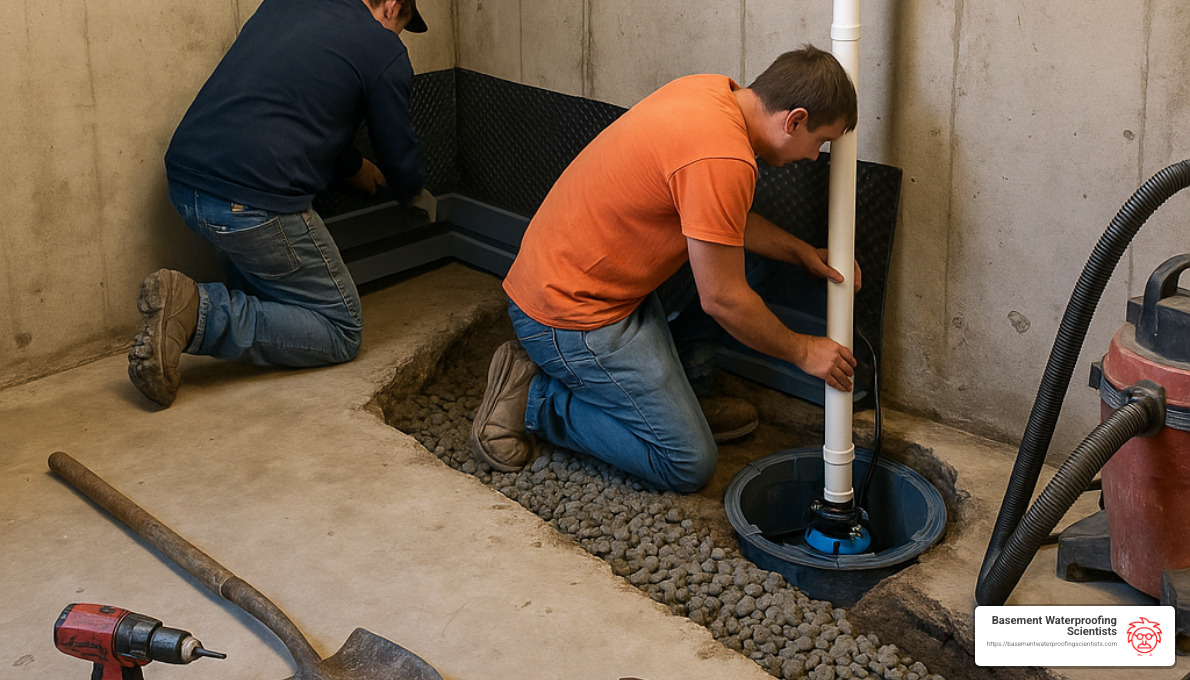
After working in Pennsylvania and New Jersey basements for over 30 years, I can tell you that effective moisture control requires a multi-pronged approach. We need to prevent water from entering, manage humidity levels, seal those sneaky entry points for moisture vapor, and address condensation through proper insulation and air movement. This comprehensive approach not only freshens your air but protects your home’s structural integrity—saving you thousands in potential repairs down the road.
Keep Relative Humidity at 30-50% for Basement Air Quality Improvement
The sweet spot for basement humidity is between 30-50%. Think of it as the “Goldilocks zone” for your basement air—not too dry, not too damp, but just right. When humidity drops below 30%, you might notice increased static electricity, dry skin, and even respiratory irritation. Let it climb above 50%, and dust mites start multiplying like crazy while mold risk increases. Above 60%? That’s when active mold growth becomes not just possible but likely.
Most basements in our region need a dedicated dehumidifier to maintain this optimal range. I often tell homeowners that choosing the right dehumidifier is like picking the right tool for a job—size matters! For most homes around Philadelphia, I recommend commercial-grade units that remove 70-95 pints of moisture daily.
Yes, these units cost more upfront ($1,000-$1,500), but they’re workhorses that outperform and outlast standard consumer models. Look for features like built-in humidistats (they automatically maintain your target humidity), continuous drainage options (no more emptying buckets!), and low-temperature operation capability (crucial for naturally cool basements).
As our lead technician often says, “Many homeowners make the mistake of buying units that are too small for their space. It’s like bringing a knife to a gunfight—you’re just not properly equipped for the battle against moisture.”
Stop Moisture at the Source: Seal Cracks & Gaps
While dehumidifiers handle airborne moisture, they can’t stop water from entering your basement in the first place. Water is sneaky—it finds its way through foundation cracks, porous concrete walls, floor-wall joints, window wells, utility penetrations, and even sump pit openings.
Sealing these entry points is like plugging holes in a leaky boat—essential for staying afloat! Proper sealing prevents water infiltration, blocks dangerous radon gas, keeps pests out, improves energy efficiency, and improves overall air quality. It’s a total win for your home’s health.
At Basement Waterproofing Scientists, we use specialized polyurethane sealants that remain flexible even as your foundation shifts with seasonal changes. This flexibility is crucial—rigid sealants crack and fail when your foundation moves even slightly.
I remember one client in Pottstown who had been running multiple dehumidifiers for years, fighting a never-ending battle against basement moisture. After we identified and sealed over a dozen small foundation cracks, their basement humidity dropped by 15%—and that was before we even upgraded their dehumidification system! Sometimes the simplest fixes make the biggest difference.
Waterproofing Upgrades That Boost Air Quality
For basements with significant moisture issues, comprehensive waterproofing systems provide the most effective long-term solution for basement air quality improvement.
Interior drainage systems manage water that enters through walls or under the foundation by channeling it to a sump pump. These systems include perimeter drainage channels that capture water before it reaches your floor, wall drainage membranes that direct water downward, and properly designed sump systems to evacuate that water safely away from your foundation.
A quality sump pump system is truly the heart of basement moisture control, especially in areas with high water tables like parts of Philadelphia and Reading. Modern systems go beyond just a basic pump—they include battery backups for power outages, water-powered backup options for extra protection, alarm systems that alert you to problems, and even smart monitoring that sends notifications to your phone. We always recommend sealed sump pits to prevent radon and moisture vapor from entering your living space.
For crawlspaces and some basement walls, vapor barriers provide remarkably effective moisture control. These 10-20 mil polyethylene sheets create a physical barrier that stops ground moisture in its tracks. Proper installation requires full coverage of earth floors in crawlspaces with carefully sealed seams and edges, ideally integrated with your drainage systems for complete protection.
Yes, comprehensive basement waterproofing typically costs between $4,000 and $8,000 depending on your basement’s size and condition. That’s a significant investment, but consider this: a properly waterproofed basement addresses the root cause of most air quality issues while protecting your home’s structural integrity for decades to come.
I’ll never forget a family in Bristol Township who called us after spending over $3,000 on various DIY waterproofing attempts and portable dehumidifiers. They were frustrated and nearly ready to give up on their basement. After we installed a proper interior drainage system and sump pump, their basement stayed bone-dry even during heavy storms. The improvement in their indoor air quality was so dramatic that they finally converted their basement into the family room they’d always wanted. That’s the power of addressing moisture at its source!
Want to learn more about our moisture control solutions? Check out our detailed resources on Basement Waterproofing Solutions, Crawlspace Vapor Barrier Installation, and Sump Pump for Basement.
Boost Fresh Air: Ventilation Strategies That Work
Once you’ve tackled moisture problems, the next step in basement air quality improvement is all about improving ventilation to get fresh air circulating. Even the driest basement can develop that stale, unpleasant smell if air sits still for too long.
To maintain air quality, it is crucial to ventilate your basement effectively. Think of ventilation as your basement’s breathing system. Without it, pollutants have nowhere to go but up into your living spaces. Good ventilation does several important jobs: it flushes out indoor pollutants, helps manage humidity levels, prevents radon buildup, brings in oxygen-rich air, and helps maintain comfortable temperatures year-round.
Let’s explore some practical ways to get your basement breathing properly again:
Pros & Cons of Opening Basement Windows
The simplest solution is often right in front of us – basement windows. But before you start propping them open, there are some important considerations:
Pros:
– It’s completely free (if you already have windows)
– Uses zero energy
– Provides immediate fresh air
– Can quickly clear out paint fumes or other temporary odors
Cons:
– It’s weather-dependent (not much help during Pennsylvania winters!)
– Can actually make humidity worse during muggy summer months
– Creates potential security vulnerabilities
– Offers limited benefit for deep basements with few windows
– Requires someone to remember to open and close them
– May let in pollen, dust and other outdoor irritants
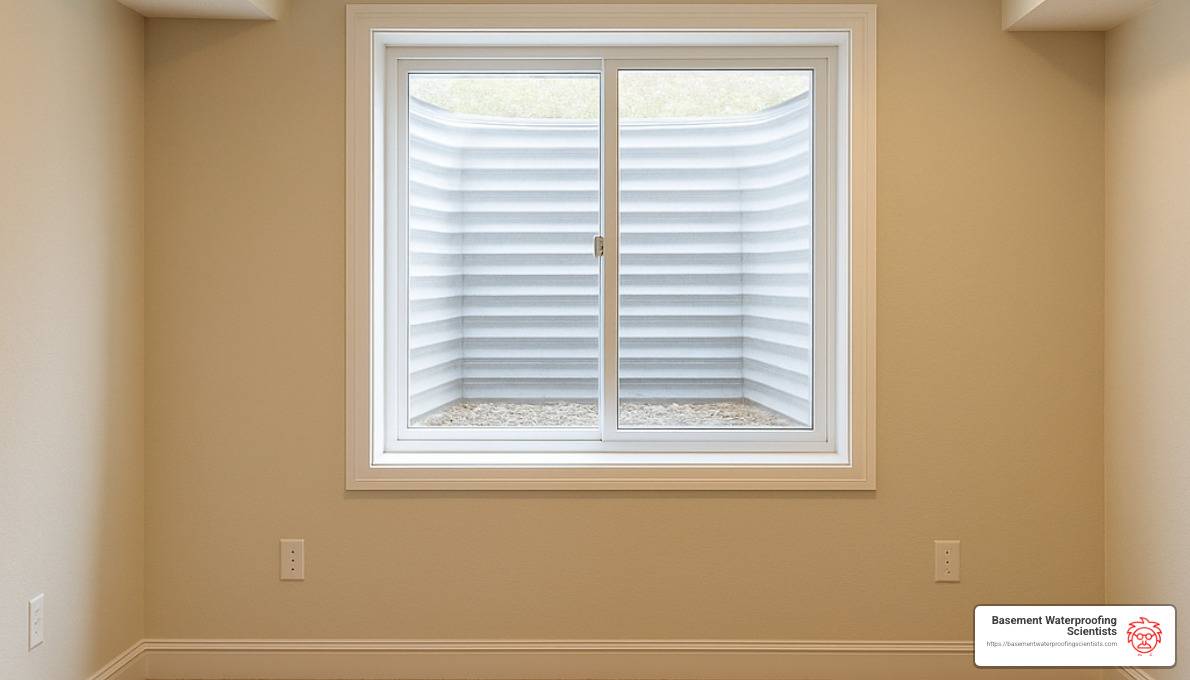
As one of our ventilation specialists often tells clients, “Opening windows works beautifully during those perfect fall days, but it’s like running your air conditioner with the windows open during humid summer months – you’re just inviting moisture problems back in.”
If window ventilation is your primary strategy, consider upgrading to modern egress windows. They provide better airflow while also offering a safe exit in emergencies. While they typically cost between $1,500-$3,500 installed, they add significant value in terms of safety and usability.
Mechanical Options for Year-Round Basement Air Quality Improvement
For reliable, consistent basement air quality improvement that works in any weather, mechanical ventilation systems are your best bet:
Exhaust-Only Systems pull stale air out of your basement through bathroom-style exhaust fans, inline duct fans, or window fans set to exhaust mode. They’re relatively affordable ($100-$500 installed) but have one major drawback: they create negative pressure that can actually draw radon and other pollutants in through tiny foundation cracks.
Supply-Only Systems do the opposite – they push fresh air into your basement through dedicated intakes with filters. Costing around $200-$800 installed, these systems help pressurize your basement, which can reduce radon entry. However, they can sometimes push humid air into wall cavities where it might condense and cause hidden mold problems.
Balanced Ventilation Systems give you the best of both worlds. Systems like Heat Recovery Ventilators (HRVs) and Energy Recovery Ventilators (ERVs) simultaneously bring fresh air in while exhausting stale air out. The magic happens in the core, where they transfer heat between the airstreams, saving energy. At $1,000-$3,000 installed, they’re not cheap, but they’re incredibly effective for year-round use in our Pennsylvania climate.
I’ll never forget a Haverford Township family we worked with who struggled with musty odors despite controlling moisture. After installing an HRV system, not only did their air quality dramatically improve, but they were thrilled to find the system recovered over 70% of the heat from exhausted air during winter, keeping their energy bills in check.
| Ventilation Type | Airflow Rate | Installation Cost | Energy Usage | Maintenance | Best For |
|---|---|---|---|---|---|
| Natural (Windows) | Variable | $0 (existing) $1,500+ (new) |
None | Minimal | Occasional use, mild/dry weather |
| Exhaust-Only | 50-200 CFM | $100-$500 | Low | Filter cleaning | Unfinished basements, low radon risk |
| Supply-Only | 50-200 CFM | $200-$800 | Low | Filter replacement | High radon areas, finished basements |
| Balanced HRV/ERV | 100-300 CFM | $1,000-$3,000 | Moderate | Filter/core cleaning | Finished basements, energy-conscious homes |
| HVAC Integration | 100-400+ CFM | $500-$2,000 | Varies | Standard HVAC maintenance | Finished living spaces, whole-house approach |
For most homes we work with in the Philadelphia area, we typically recommend a thoughtful combination of approaches: a good mechanical system for year-round reliability, with window ventilation as a bonus option during those perfect spring and fall days when outdoor conditions are ideal.
After 30 years of helping Pennsylvania homeowners breathe easier, we’ve found that proper ventilation isn’t just about comfort – it’s about creating a healthier environment for your entire home, starting from the bottom up.
Clean the Air: Dehumidifiers, Purifiers & Filters
Even with excellent moisture control and ventilation, some contaminants will inevitably remain in your basement air. This is where air cleaning technologies come into play as a critical component of comprehensive basement air quality improvement. Air purifiers, in particular, are effective tools for eliminating airborne contaminants, including mold spores and other allergens.
The three main categories of air cleaning equipment are:
- Dehumidifiers: Remove moisture from the air
- Air Purifiers: Filter out particulates and sometimes gases
- Integrated Systems: Combine dehumidification with air filtration
Each plays a distinct role in creating healthier basement air.
Choosing the Right Dehumidifier for Basement Air Quality Improvement
Dehumidifiers are the workhorses of basement air quality improvement, especially in humid climates like Pennsylvania and New Jersey. Here’s how to select the right one:
Sizing Guidelines:
– For slightly damp basements: 10 pints per 500 sq ft
– For moderately damp basements: 12 pints per 500 sq ft
– For very damp basements: 14-16 pints per 500 sq ft
– Add 4-5 pints for each additional 500 sq ft
For example, a 1,500 sq ft moderately damp basement would require a dehumidifier rated for at least 36 pints per day (12 pints for first 500 sq ft + 8 pints for second 500 sq ft + 8 pints for third 500 sq ft).
Key Features to Look For:
– Built-in humidistat: Automatically maintains target humidity
– Auto-restart: Resumes operation after power outages
– Low-temperature operation: Functions properly below 65°F
– Auto-defrost: Prevents coil freezing in cool basements
– Continuous drainage options: Eliminates manual emptying
– Washable/replaceable filters: Captures dust and protects the unit
– Energy Star rating: Reduces operating costs
For basements with persistent moisture issues, commercial-grade dehumidifiers like the SaniDry™ models offer superior performance, removing up to 95 pints per day while consuming less energy than multiple smaller units.
“Standard residential dehumidifiers are often overwhelmed by basement conditions,” explains our equipment specialist. “Commercial-grade units cost more upfront but last longer, remove more moisture, and actually cost less to operate per pint of water removed.”
Selecting an Air Purifier That Handles Basements
While dehumidifiers address moisture, air purifiers target particulates and gases that affect air quality. For effective basement air quality improvement, look for these features:
Filtration Technologies:
– True HEPA filtration: Captures 99.97% of particles as small as 0.3 microns (including most mold spores which are typically 2-10 microns)
– Activated carbon filters: Absorb odors, VOCs, and gases
– UV-C light: Kills or inactivates mold, bacteria, and viruses
– Ionization: Charges particles so they stick together and become easier to filter (look for ozone-free models)
According to scientific research on HEPA filtration, these filters can remove the vast majority of airborne allergens and contaminants, making them essential for basement environments where pollutants tend to accumulate.
Sizing and Placement:
– Clean Air Delivery Rate (CADR): Should match or exceed your basement’s square footage
– Air Changes Per Hour (ACH): Aim for at least 3-5 ACH for basements
– Placement: Position units away from walls and obstructions
– Multiple units: Consider several smaller units rather than one large unit for better coverage
Special Basement Considerations:
– Humidity resistance: Units should function properly in higher humidity
– Robust pre-filters: Protect main filters from basement dust
– Quiet operation: Especially important for finished basements
– Filter replacement costs: Factor this into your budget
For a client in Springfield Township with severe allergies, we recommended a multi-stage air purifier with true HEPA filtration and a substantial activated carbon filter. Within weeks, their allergy symptoms noticeably improved, and basement odors were eliminated.
Maintenance Routines That Keep Equipment Effective
All air quality equipment requires regular maintenance to perform optimally. Establish these routines for maximum effectiveness:
Dehumidifier Maintenance:
– Weekly: Check and empty water collection bucket (if not using continuous drainage)
– Monthly: Clean or replace air filter
– Quarterly: Clean coils and check for ice buildup
– Annually: Deep clean unit, check drain hose for blockages or mold growth
– Every 5-7 years: Consider replacement if efficiency declines
Air Purifier Maintenance:
– Monthly: Clean pre-filters and check main filter condition
– Quarterly: Replace carbon filters (if applicable)
– Semi-annually or Annually: Replace HEPA filters (follow manufacturer guidelines)
– Annually: Clean internal components and fan
– Every 5 years: Consider replacement of the entire unit
Ventilation System Maintenance:
– Quarterly: Clean or replace air filters
– Semi-annually: Check fan operation and clean grilles
– Annually: Clean ductwork and check for leaks
– Every 2-3 years: Clean HRV/ERV heat exchange core
A well-maintained $200 air purifier will outperform a neglected $1,000 unit. At Basement Waterproofing Scientists, we offer maintenance plans that include regular servicing of all your basement air quality equipment, ensuring optimal performance year-round.
\
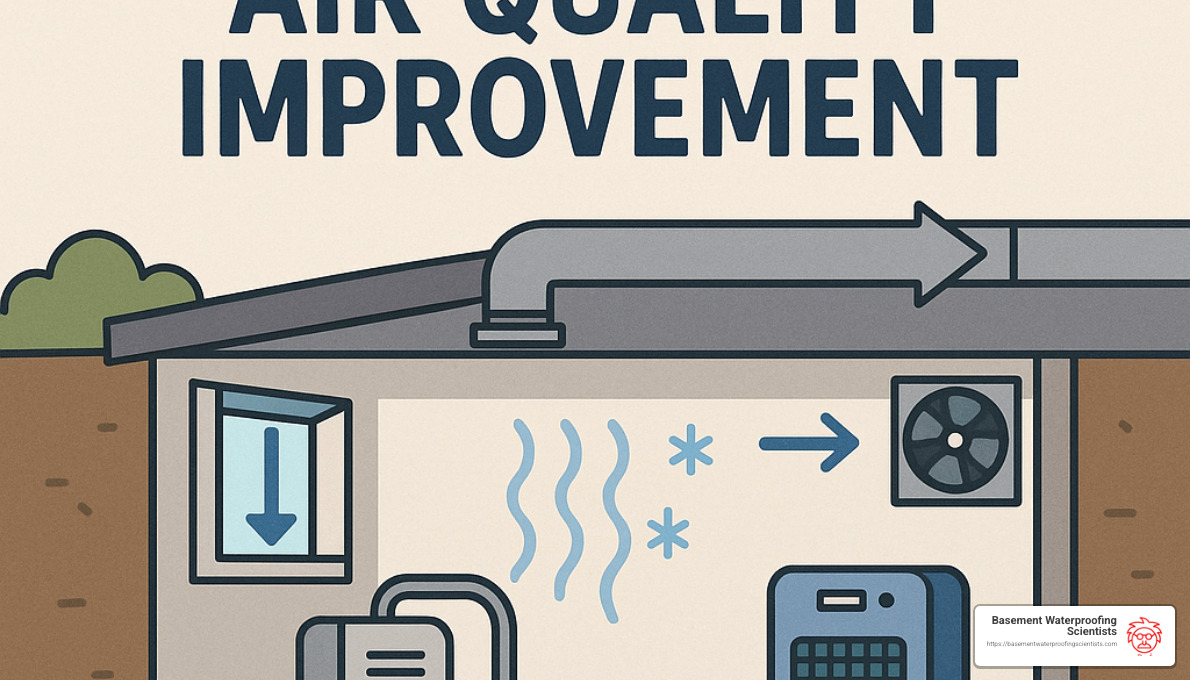
I remember a Willow Grove family who called us after finding their radon levels exceeded 8 pCi/L—twice the EPA action level. They were understandably concerned, especially with young children in the home. After installing a sub-slab depressurization system, their levels dropped below 2 pCi/L, giving them peace of mind and significantly reducing their lung cancer risk.
Reducing VOCs & Chemical Off-Gassing
That “basement smell” might not just be moisture—it could be Volatile Organic Compounds (VOCs) accumulating in your poorly ventilated space. These gases emit from numerous household products and building materials, and they can impact your health in subtle but significant ways.
Your basement likely contains several VOC sources:
Stored chemicals like paints, solvents, cleaning products, and automotive fluids often find their way to basement storage shelves. Even sealed containers can release small amounts of VOCs over time.
Building materials including new carpeting, vinyl flooring, adhesives, and pressed wood products can off-gas for months after installation.
Mold and bacteria produce their own Microbial VOCs (MVOCs), which contribute to that musty smell and can trigger respiratory issues.
“One of the simplest improvements you can make is relocating chemical storage to a detached shed or garage,” I often tell homeowners. “If that’s not possible, use sealed plastic containers rather than keeping items on open shelves.”
For effective VOC reduction, consider a multi-pronged approach:
First, control the source by removing unnecessary chemicals and properly storing those you need to keep. When renovating, choose low-VOC alternatives for paints, flooring, and furniture. Increase ventilation significantly after new installations or renovations, and consider using activated carbon air purifiers specifically designed to capture gaseous pollutants. Finally, maintain moderate temperature and humidity levels to reduce off-gassing rates.
I worked with a family in Upper Darby Township who was renovating their basement into a playroom. We helped them create a healthier space by recommending low-VOC building materials, proper ventilation during and after construction, and running a carbon-filter air purifier for three months after completion. The result? A comfortable play area without the typical “new renovation” chemical smell.
What humidity level should my basement stay under?
Your basement humidity should ideally stay between 30% and 50%. This sweet spot prevents mold growth while avoiding the problems that come with excessive dryness. During those sticky Pennsylvania summer months, you might need to accept 50-55% in extremely humid weather, but never let it creep above 60% for long.
“I tell homeowners that maintaining proper humidity is like the foundation of a house—everything else builds on it,” says our moisture control specialist Mark. “Once you hit 60% humidity, mold can start growing on organic surfaces within just a day or two.”
If your dehumidifier seems to be fighting a losing battle against humidity, you’re probably dealing with one of four issues: your unit is too small for the space, you need multiple units for better coverage, you have water coming in somewhere, or poor air circulation is creating humid pockets in corners.
How can I tell if mold in my basement is dangerous?
All visible mold deserves attention, but not all mold poses the same health risks. Here’s what you need to know:
Size matters – Small areas (less than 10 square feet) can often be safely cleaned by homeowners using proper precautions. Larger areas should be professionally addressed.
Color isn’t reliable – Despite what you might have heard, you can’t determine how dangerous mold is just by its color. That scary “black mold” might be less harmful than a lighter-colored variety.
Location counts – Mold growing on organic materials like paper, wood, or drywall is more concerning than mold on concrete, which has less “food” for the mold to digest and spread.
Health symptoms – If mold appears around the same time as new respiratory symptoms, assume it’s problematic until proven otherwise.
The only definitive way to identify mold species is through professional testing. At Basement Waterproofing Scientists, our testing services identify exactly what types of mold are present and their concentration levels, so you know exactly what you’re dealing with.
For visible mold, our practical advice is simple: first, fix what’s causing the moisture; second, clean small areas with appropriate biocides; third, call professionals for larger areas or if anyone is experiencing health symptoms; and finally, implement proper basement air quality improvement measures to keep it from coming back.
A client in Media had been unsuccessfully battling bathroom mold for years before finding it was actually being caused by humidity from their basement traveling upward through the home. Once we addressed the root cause with proper basement waterproofing and dehumidification, their bathroom mold issues disappeared for good.
